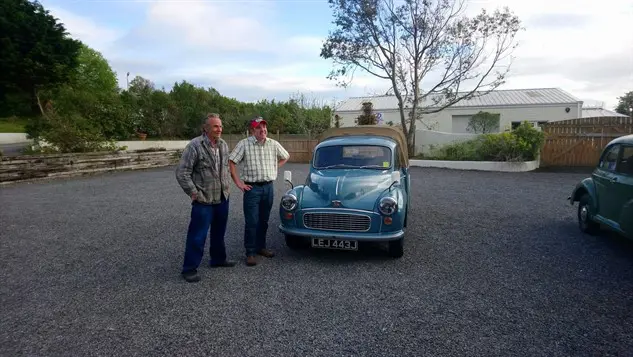CAR OF THE MONTH – MEIRION WOOLF AND HIS AUSTIN 8 CWT “MINOR” PICK-UP
29 January 2020
Two years ago, Meirion Woolf brought himself a rather splendid present for his 40th birthday.
‘My parents owned a 1953 “Split Screen” and ever since then I’ve been a Minor fan’ - and so he acquired LEJ 443 J.

However, ‘some members of the public are confused by the badging’, for this is not a “Morris” but an Austin 8 cwt pick-up with less than 50,000 miles on the clock.
As Meirion remarks, the demise of the A35 Van in early 1968 meant that BLMC ‘panicked and rushed” the rebadged model into production to provide Austin dealers with a replacement.
The two versions were identical, asides from their grilles and badges, and Leyland even issued separate brochures that used the same illustrations.
The Austin and the Morris were sold in 6 cwt and 8 cwt forms, and when the Marina Van succeeded them in 1972, they were virtual street furniture.
The Minor van and pick-up made their bow in April 1953 as the replacements for the long-running Morris Series Z.
Commercial Motor thought the former combined a ‘smart appearance with economy and speed’, that the ‘four-speed gearbox is practically foolproof’ and praised how it could withstand ‘the efforts of those who are unskilled or have little knowledge in the art of driving’.
By 1962 the Minors gained the 1,098cc A-series engine, plus a courtesy lamp and windscreen washers as standard equipment.
The “Clipper Blue” pick-up is distinguishable from its 6 cwt counterpart by its heavy-duty tyres, and the interior is free from distracting frivolities; this is a vehicle where the passenger seat was an optional extra.

The Austin’s appearance is so immaculate that it is hard to believe that when he came across the 8 cwt, it had ‘been in a shed for the previous 26 years’.
The pick-up was ‘located just 15 miles away from my house. When I bought it, the bodywork had been done, but the engine, the brakes, the clutch, the hoops and the canvas tilt all needed work and the interior was covered in dust’.
Fortunately, the Austin was sufficiently restored to health to convey Meirion to the 2018 Great Dorset Steam Fair and the 2019 Practical Classics Classic Car & Restoration Show.
Today, it often attends meetings of the Knighton Historic Vehicle Club - https://www.khvc.co.uk/. In terms of modifications, the 8 cwt now sports an alternator and a new tilt ‘made by Comptons 2000 in Birmingham’, and it looks as ready for duty as it was back in 1970.
‘A farmer in Lampeter bought my Austin, and he kept it for ten years before selling it to a local garage’.
The 8 cwt was then ‘sold to a milkman whose name is J.G. Davies, and through researching my pick-up’s history, I recently met him’.
The Austin was used on the milk rounds for a decade and at that time ‘it wasn’t fitted with the canvas tilt as the first two owners needed quick and easy access to the load bay’.
When Commercial Motor evaluated the Austin 6 cwt Van in 1969, they found it to be ‘a most practical vehicle, and one which promised to live up to its reputation for robust long life’.
It is a description that certainly applies to the Woolf 8 cwt pick-up, which now goes by the name ‘Cariad or “Welsh Rose”’.
Meirion finds it ‘brilliant to drive’ and is looking forward to brimming the pick-up to the NEC for a second time.
Perhaps the only problem he regularly encounters is ‘whenever I go to a garage for petrol, someone always tries to buy it from me!’. There would seem to be little chance of that happening.
With Thanks To - Meirion Woolf.
